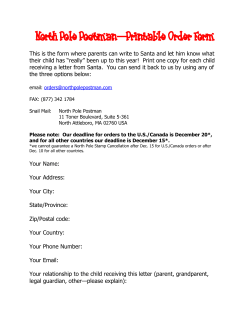
REVISION WORKSHEET 1 SOCIAL SCIENCE CLASS V 1. Fill in the
REVISION WORKSHEET 1 SOCIAL SCIENCE CLASS V 1. Fill in the blanks: (a) On .................... and .................................. the sun is directly over head at the Equator. (b) Height of a place above the sea level is called ........................ (c) Fixed path on which the planets move around the sun is called .................... (d) The temperature ....................... as the height of the land increases. (e) Tents made of animal skin are called ............................ (f) ................................ is known as the “Land of the Rising Sun”. (g) The North Pole lies on an ocean called the ............................ ocean. (h) The earth’s ............................. influences the direction of the flow of ocean currents and the winds. (i) A huge piece of ice that breaks off from a glacier is called ....................... (j) Places near the sea have ............................ climate. 2 Define: (a) Harpoon (b) Humidity (c) Frigid Zone (d) Blubber (e) Sea Breeze (f) Revolution 3. Differentiate between: (a) (b) Summer Solstice and winter solstice Weather and Climate REVISION WORKSHEET 2 SOCIAL SCIENCE CLASS V 1. Answer the following questions: (a) How is a leap year calculated? (b) During rotation of the earth, only one part of the earth faces the sun. Why do you think that is? (c) If 1996 was a leap year ,when was the previous leap year? (d) Why do Inuits now live in towns? 2. Give reasons for the following: (a) We do not feel rotation and revolution of the earth. (b) Greenland is called the “Land of the Midnight Sun”. (c) The life of Inuits has changed in the last few years. (d) Areas falling under Torrid Zone experience hot and humid climate. (e) Seasons play an important role in our lives. 3. Write ‘True’ or ‘False’. (a) The altitude of a place is measured against the sea level. ( ) (b) Sheep rearing is an important activity in Greenland. ( ) (c) There are 365 days in a leap year. ( ) (d) The rotation of the earth causes seasons. ( ) (e) The Inuits called Greenland Kalaallit Nunaat. ( ) (f) The scientists who study the weather are called cartographers. ( ) ANSWER KEY OF REVISION WORKSHEET 1 1. Fill in the blanks: (a) 21st March and 23rd September (b) altitude (c) orbit (d) decreases (e) Tou - pigs (f) Japan (g) Arctic Ocean (h) rotation (i) ice berg (j) moderate 2. Define: (a) Harpoon: A spear with a rope attached to it is called harpoon. (b) Humidity: Amount of moisture present in the air is called humidity. (c) Frigid Zone: The heat zone that lies between the Arctic Circle and the North Pole in the Northern Hemisphere and between the Antarctic Circle and the South Pole in the Southern Hemisphere is called Frigid Zone. (d) Blubber: Fat of animals like whale or seal is called blubber. (e) Sea Breeze: During the day, a cool breeze blows from sea to land. This is called Sea Breeze. (f) Revolution: The movement of the earth around the sun on a fixed path is called revolution. 3. Differentiate between: (a) Summer Solstice and winter solstice Summer Solstice 1. The length of the days are longer than nights. 2. 21st June is the longest day of the year. 3. North Pole gets 24 hours of daylight whereas South Pole has darkness. (b) Winter Solstice 1. The length of the nights are longer than days. 2. 21st December is the longest night of the year 3. South Pole gets 24 hours of daylight and North Pole has darkness. Weather and Climate Weather 1. The condition of the atmosphere at a given time and place is called weather. Climate 1. Climate is the average weather condition of a large area over a long period of time 2. Weather changes from time to time. 2. Climate is fixed. 3. Weather can be sunny, cloudy, rainy etc 3. Climate can be extreme, moderate, temperate etc. ANSWER KEY OF REVISION WORKSHEET 2 1. Answer the following questions: (a) The earth takes 365 1/4 days to revolve around the sun. But in our calendar, a year has only 365 days. The quarter of a day is accumulated and after four years when it becomes a full day, it is added to that particular year to the month of February which has 29 days. Thus, leap year is calculated. (b) During rotation, due to the spherical shape of the earth only one part of the earth faces the sun. The part which is towards the sun gets light and experience day, the part which is away from the sun has darkness and experience night. (c) 1992 was the previous leap year. (e) Inuits now live in towns because these towns have modern facilities like schools, colleges, hospitals, entertainment etc. 2. Give reasons for the following: (a) We do not feel rotation and revolution of the earth because we and everything else on the planet are also moving with the earth. (b) Greenland is called the “Land of the Midnight Sun” because during summer solstice the sun never sets for a month in Greenland. We can see the midnight sun at the horizon. (c) The life of Inuits has changed in the last few years because they have started living in the houses built of stone and wood. Now they use rifles to hunt animals and motorboats to fish. They have also started living in towns which have facilities like schools, colleges, hospitals, entertainment etc. They also use motorised sledges called skidoos for travelling on land. (d) Areas falling under Torrid Zone experience hot and humid climate because the sun’s rays fall directly over these areas. (e) Seasons play an important role in our lives because they determine the food we eat, the clothes we wear, the kind of houses we live in and even the crops that farmers grow. 3. Write ‘True’ or ‘False’: (a) True (b) True (c) (d) False False (e) True (f) False
© Copyright 2025





















